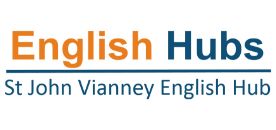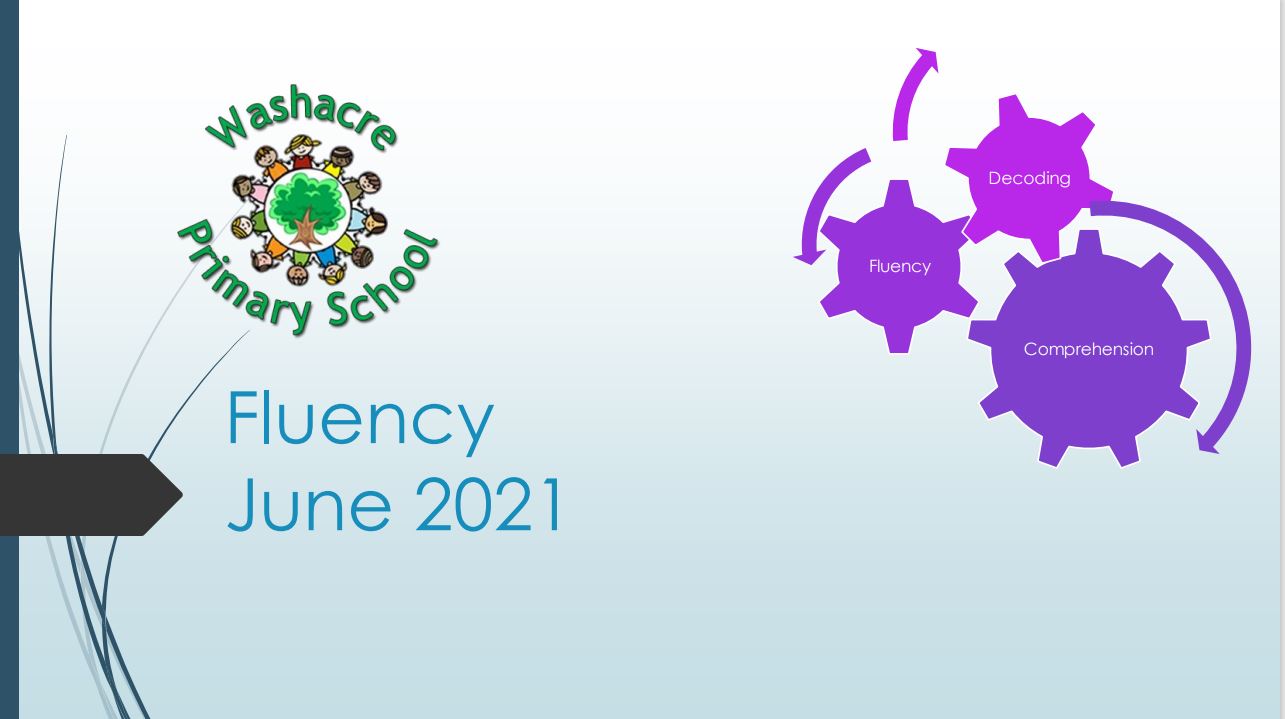Quality First Teaching and Fluency Across the Curriculum
“Fluency is the bridge between phonics and comprehension.”
“So it is with children who learn to read fluently and well: they begin to take flight into whole new worlds as effortlessly as young birds take to the sky.”
Example Staff CPD – click on the image to download:
Ways of Supporting Children’s Fluent Reading
We use some different approaches to support this repetition. The techniques, approaches and activities we use in this project support different phases of the lessons.
Modelled reading
Modelled reading (reading to the group) involves children listening to a text read aloud by the adult. The adult models skilled reading behaviour when reading in a range of different types of text and styles of writing. It provides an opportunity to demonstrate reading as an enjoyable activity, and allows children to see a purpose in learning to read. [expand title=”CLICK HERE to read more”]
Modelled reading can be used for many different teaching and learning purposes in the classroom, but within this programme we are using it to demonstrate reading which is fluent, appropriate in its pace and its use of prosodic features (phrasing and intonation). The adult is modelling accurate and fluent reading in order to maintain interest, add to the meaning of the text, build children’s confidence and to take away the decoding challenges in the text.
Given the fluency focus of this programme it is important that the modelled reading demonstrates the skills we want the children to emulate in the all reading they do in the lesson and beyond it. So as well as making sure that the text sounds interesting and engaging, the adult needs to read:
- At an appropriate pace
- Taking appropriate account of punctuation
- Identifying other text features which might influence the reading aloud
- Chunking words together, recognising meaningful units
- With expression [/expand]
Repeated reading
Repetition is a key element in this fluency into comprehension programme. [expand title=”CLICK HERE to read more”] Children who are still struggling to read fluently at KS2 and beyond are likely to be aware of their difficulties. This awareness starts to impact negatively on their attitude to reading, their confidence and their motivation. Each repetition builds their level of accuracy and their pace of reading, allowing them to sound more like a good reader. Each repetition builds confidence by letting them hear themselves becoming more successful. And each repetition inches them towards more skilled reading practice.
In each fluency focused lesson in the programme the child should hear the text read aloud at least four or five times. This build-up of opportunities occurs in the adult modelling section of the lesson, the re-read section where the group use choral and echo techniques to read with adult, and in the practise section where they read independently or in pairs.[/expand]
Surveying the text
Start by identifying obvious punctuation – full stops, commas – which indicate where to pause or take a breath. At the start of the programme full stops and commas are the most important clues to highlight.[expand title=”CLICK HERE to read more”]
- Point out where lines of text ‘run on’, i.e. the sentence and hence the reading does not stop with the end of the line. Talk about how to read a longer sentence, e.g. by taking a small breath at some point where it won’t disrupt the flow.
- Identify and talk about any words you think will be challenging for the group to read. Read the word to them and get them to repeat the reading.
- Don’t spend time segmenting and blending the phonemes in this challenging word, rather give the group the word and get them to repeat it. It will be important to keep the focus on fluent, smooth reading even when the text is difficult.
- Highlight any other text features which determined the reading you modelled, e.g. question marks, words in bold, etc.
- Point out words which need to be read together as a unit. We call this chunking the text and it means reading words which are linked without too much of a break between them. Noun phrases are likely to be the first chunks that you identify and use in your modelling.
- Emphasise other clues when you use them, e.g. speech verbs or adverbs which indicate how someone says something. This is likely to become more important as the programme progresses.[/expand]
Leading reading
Most of the time when you are reading with the group, the adult will be leading by example, giving children confidence to join in with the reading by very obviously leading them through the text and taking away any decoding challenges which might disrupt the fluency of the reading.[expand title=”CLICK HERE to read more”] In particular, the choral reading activity is likely to be strongly led by the adult, providing a very clear model for the group to follow and allowing the less confident reader to read without feeling any pressure to be accurate, fluent or expressive.
There is no need for the adult to feel that they have to ‘perform’ when leading reading. Certainly look to make your voice expressive but there is no requirement to be dramatic or overdo the emotion. A solid reading, using the obvious punctuation clues and chunking the text so it makes reasonable sense is sufficient. Try to read at normal talking pace or perhaps just a little slower. To lead the reading the adults needs to:
- Know the text or section of text well
- Identified the clues that they will talk about later
- Practise
- Be clear in their reading so all the group can hear you
- Be prepared to drop the pace of the reading or stop altogether and start again, should the group get lost[/expand]
Reading sotto voce
Whilst most reading the adult does will be as the group leader, sometimes it might be appropriate for the adult to drop their voice a little and read more quietly. This allows you to observe the group a little more closely and also recognise their growing confidence and fluency. You are most likely to read in this way when re-reading the familiar text at the start of lesson, rather than when working on the new text.
Echo Reading
‘Echo reading is when the adult reads a short segment of text aloud and the children echo the reading back.’[expand title=”CLICK HERE to read more”]
Echo reading is a re-reading strategy designed to help students develop expressive, fluent reading as well as used for print knowledge. In echo reading, the teacher reads a short segment of text, sometimes a sentence or short paragraph, and the children echo it back. “Echo reading works best for short segments of text as particularly well-suited for beginning readers” (Jennings, Caldwell, and Lerner, 2014).
It is important that the child- reader follow the text when the adult is reading and when they echo the adult’s reading back to them, so each child needs their own copy of the text. Alternatively, you could use a big book or enlarge and project a text onto a screen. If it is helpful, let the children point at the word as you – and then they – read it, but be careful to make sure that they do not cover other words or the rest of the line. Remember we want to encourage fluent reading of a meaningful phrase or ‘chunk’ of words, not word by word reading.
- Using an appropriate text, the adult reads the whole section to the group, making the reading sound interesting and expressive and paying attention to ‘clues’ – mainly punctuation clues like commas and full stops to begin with.
- Then re-read a short segment of text to the group, modelling fluent reading. This may be a complete sentence or a phrase or clause in a particularly long sentence. It is important that the segment is meaningful, it must make sense.
- The children then repeat or echo the segment of text that the adult has just read.
- Then the adult does the same with the next short segment of text, stopping at an appropriate place. Once again the children echo the adult’s reading.
- This continues until the section of text is completed.
- If some of the children are finding it difficult to follow the text or to read along with the others, then there is no problem to repeat a segment. The adult might slow down the modelled reading so that the echoed reading is also slower.
Children can also use the echo reading technique during the practise stage of the lesson. Working in pairs they can take it in turns to lead their partner through the text, using a call and response or echo approach.[/expand]
Choral Reading
‘Choral reading is where the teacher and children read the same passage aloud at the same time.’[expand title=”CLICK HERE to read more”]
Choral reading is reading aloud in unison with a whole class or group of children. It helps build children’s fluency, self-confidence and motivation. Because children are reading aloud together, children who ordinarily may feel self-conscious or nervous about reading aloud have built in support. (Reading rockets)
Choral reading provides less skilled readers the opportunity to practise, provides a model of fluent reading and helps improve the ability to read words on sight.
Use a text or section of text that works well for reading aloud as a group, e.g. a text with patterned language which is not too long. Poems often work well.
Re-read the text together, both you and the children reading the text in unison.
With an unfamiliar text you may need to more obviously lead the reading, giving the children confidence by taking away the decoding challenges in the text.
When reading a more familiar text together, the adult may wish to drop the volume of their reading for part of the text. (Sotto voce reading.) You don’t stop reading but just play a less central role. This will give you an indication as to whether everyone is joining in, or let you observe a particular child more closely. Be ready to retake the leadership role if the text gets challenging or the group reading begins to falter. Remember each re-reading, however done, must sound good![/expand]
Paired or partner reading
Paired reading is a research based strategy helpful to readers who lack fluency. In this intervention programme you are most likely to use paired reading during the practise stage of the lesson, when children are working together. It is important that this approach is only used, at least in this programme, when children are familiar with a text, i.e. they have already read it a number of times.[expand title=”CLICK HERE to read more”]
In a paired reading activity, partners read aloud to each other. Pairs can be of the same reading level or you could combine a better reader with a weaker, less fluent reader.
In general, paired reading can be used with any book, but in this programme we use paired reading on the texts that the children have just read with the adult. The partners take turns to read, reading sentence by sentence, paragraph by paragraph or section by section. The amount to be read might be agreed beforehand or you might ask children to develop a signal which indicates when they want their partner to take over the reading. Passing the reader over to their partner should only happen at a legitimate pause point, e.g. the end of a sentence or paragraph.
You might also want to discuss with the pairs what should happen if a reader makes a mistake or can’t read a particular word. Hopefully this won’t happen too often as the children will already have heard and read the text a number of times. But if it should happen the children should know what to do. The best solution is probably that they go back to the start of the sentence (where the difficulty is located) and re-read the whole sentence together. Remember we want to avoid word by word reading, so it is important that any difficulty is addressed by re-reading the whole sentence.
Paired reading can take many forms and you may settle quickly into an approach that the group enjoy and therefore want to repeat, alternatively you may want to try different models. You might ask the pairs to:
- Read in a particular tone of voice
- Read as if one of the characters was speaking or telling the story
- Read with a particular emotion in their voice, e.g. as if frightened, angry
- Read as if they were a newsreader on television, or someone making an important announcement
- Reading as if they are sucking on a sweet, etc.
Please feel able to experiment, the aim is to increase the number of repetitions and re-readings, whilst at the same time have fun. It is however probably best to avoid asking the group to read very slowly or very quickly, as these are approaches we want to eliminate from their repertoire at this stage in their development.[/expand]
Readers’ theatre
Readers’ theatre can be used in the practise stage of the intervention lesson in order to develop children’s fluency. [expand title=”CLICK HERE to read more”]It involves children reading part of a text aloud as if it were a play script. Children can be allocated or choose a particular part or section of the text to read and be asked to prepare their reading, practising it aloud several times. They then present their prepared reading to the adult and the rest of the group. There is no requirement to memorise anything as they will be reading from the text.
- As readers’ theatre involves an element of presentation it is probably best used when the group are reasonably confident about reading aloud to each other. It is not a strategy to use with children in the early stages of this programme.
- Readers’ theatre is not used here to develop acting or drama skills and there is no need for children to adopt the voice of the character. Our aim is fluent, expressive reading not talking in role
- The best texts for readers’ theatre include lots of dialogue, although the approach can be used with all kinds of texts, including non-fiction texts.
- If the prospect of doing this individually is a bit daunting, then children could practise a section as a pair, agreeing on a shared reading which they later read to the group, working together.
- It might be helpful for the children to be able to annotate the text when doing readers’ theatre, in order to prepare their performance, e.g. identifying and remembering where to pause, when to increase or decrease the volume, or when to increase the pace of the reading. You may need to teach them how to do this efficiently.[/expand]
The one minute read
Use this as a technique for building motivation during the practise stage of the fluency lesson and to require each child to do some independent reading.[expand title=”CLICK HERE to read more”]
Set a time limit, initially quite a short one like a minute, for children to practise reading a familiar text aloud to themselves. All the children in the group should do this at the same time, so an unconfident reader is not embarrassed by feeling that she/ he is being observed by others.
Take feedback from the children about how they’ve got on with the reading, how far they managed to read etc. Then ask them to do the same reading for the same time span but this time with a particular ‘slant’ to the reading, e.g. you might ask them to whisper the reading, make the reading sound as scary as possible, read it like a very old person etc. As before, all the children should read independently and at the same time. Again stop them at the agreed time and take feedback on the success of the activity. The activity could continue, either by asking the children to change the reading characteristic, e.g. this time I want you to do it differently, try reading it like …, or, if the children are confident enough, by sharing their favourite reading with the group.
- Ensure the text is familiar to the children – one they have read at least three times before
- The time limit is fairly arbitrary – but can be used to press the children to work more effectively and brings an element of fun and perhaps competition into the activity. It also ensures that the children get opportunities to repeat their reading. Beware though that the time limit doesn’t encourage over rapid reading – remember we want fluent reading at an appropriate pace.[/expand]
Smooth reading
One of the aims of this intervention is to move children beyond word by word, ‘lumpy’ reading into reading which sounds smoother, less staccato, more like someone talking to you. [expand title=”CLICK HERE to read more”]This makes it easier for the reader to hear themselves as they read and pay more attention to the meaning of what they read.
We can use this idea of smooth reading as an activity within the practise stage of the fluency lesson. Working on a small section of a familiar text, ask children to read together in pairs, reading to each other. The aim is to read the text smoothly, so that it flows and sounds good.
- Use a familiar text – one that the group have worked on over the lesson
- The adult models smooth reading to the group. The children could echo read, reading smoothly
- The adult identifies and discusses parts of the text which might be difficult to read aloud – the bumpy bits. The group discuss ways of dealing with the bumps
- In pairs, one child reads the same text as smoothly as possible to the other
- The partner comments kindly on the reading, highlighting the parts where their friend read smoothly
- The adult demonstrates smooth reading on the next section of text and so on…[/expand]










